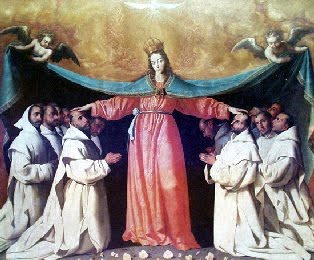 First Reading, Genesis 18:1-10a
First Reading, Genesis 18:1-10aMamre is near Hebron which is about twenty miles south of Jerusalem. The Lord appeared to Abraham there apparently in the form of three men. Saint Augustine refers to them as men in appearance only, but in reality they were angels. This part of the story will probably forever remain in obscurity. If these are angels that look like men, how does Abraham immediately identify them as angels or representatives of God? Some have suggested that Abraham didn’t know, but only that it was his nature to be hospitable. The fact that Abraham bowed to the ground and referred to himself as a servant just doesn’t seem to support this theory. In the New Testament, however, there is a passage in the Letter to the Hebrews that could at least lead one to consider this theory: ‘Do not neglect to show hospitality, for by that means some have entertained angels without knowing it’ (Hebrews 13:2). Another theory is that one of the men is Jesus Christ and Abraham bows only in adoration of Him because the story seems to hint that by the use of the word ‘Sir’ Abraham is addressing only one of the men. This theory continues by stating that this is a presage of the Trinity as Abraham adores One in Three Persons. The Catechism of the Catholic Church explains that the message to Abraham concerning his wife Sarah foreshadows the Annunciation of the true Son of the promise (cf. CCC 2571). As we read of the promise of a son for Abraham and Sarah, it is here that we can start to watch God's plan for the salvation of humanity unfold.
Second Reading, Colossians 1:24-28
The opening verse is often misunderstood. It does not mean that Christ’s sufferings are insufficient or that somehow He didn’t finish the job. Saint John Chrysostom explains: ‘Jesus Christ loves us so much that He is not content merely to suffer in His own Person, but He wishes also to suffer in His members; and thus we fill up what is wanting in the sufferings of Christ.” Notice he says ‘what is wanting in the sufferings of Christ.’ ‘Wanting’ is a more accurate translation of the Greek and perhaps even more appealing because it suggests a desire of Christ whereby ‘lacking’, the word used in this Reading, although not intending to, could easily lead one to think along the lines of insufficiency or that Christ really didn’t finish what He came to do. Saint John Chrysostom continues: ‘The wisdom, the will, the justice of Jesus Christ requires and ordains that His Body and members should be companions of His sufferings, as they expect to be companions of His glory’. Let’s face it -- no one can question the fact we are sinful creatures with a limited capacity for comprehension. We really can’t fully understand the boundless love that intimately connects us to our Lord through something as inconvenient as suffering. We won’t fully appreciate this until we get to heaven. It should be understood, however, that suffering in itself is not a means of sanctification unless it is endured patiently and accepted in obedience to God’s will. Saint Paul continues his letter with a reference to ‘the mystery hidden from ages and from generations past, but now it has been manifested to His holy ones’. This mystery is Christ's Incarnation.
Gospel, Luke 10:38-42
The unwritten law of hospitality in the ancient East would require that both Martha and Mary serve the meal for their guests. This is why Martha takes exception with Mary. One of the angles to this Gospel, which has been alluded to by so many of the saints is that this story shows the two paths of life: the contemplative life and the active life. Saint Jerome, Saint Gregory and many others agree that nothing could be found more proper for the illustration of these two states of life. Another angle to consider is that for those of us who do not live behind the walls of a monastery, the example of both Martha and Mary is necessary in our lives to help us maintain a healthy spiritual life. Mary represents the interior life, one of prayer, meditation and contemplation. Martha represents charitable works. A good prayer life helps to relieve the anxieties that cause worry and stress. You know the old saying: ‘Charity begins at home.’ Anyone who has grown up in a loving household or has ever been a parent knows how true that statement is. Parents spend countless hours trying to make a good life for their children as well as teaching them holy values. This is not an easy vocation. It requires love, patience, sacrifice and rest. All four of these attributes can be sought out through prayer. Is there anyone more equipped to learn and experience love from, than the One Who is Love Himself? Do we need to go any further than the pages of the Gospels to see the greatest Example of patience? Who better to seek out to try to understand sacrifice than He Who made the ultimate Sacrifice? Is there a more valuable way to seek rest other than Mary’s example of sitting at the Feet of Jesus? Whether our charity is inside or outside of the home, it is very difficult to be Jesus for others and see Jesus in others if priority is not given to setting aside time to experience His Love, Companionship and Wisdom – or as Our Lord calls it – the better part.











